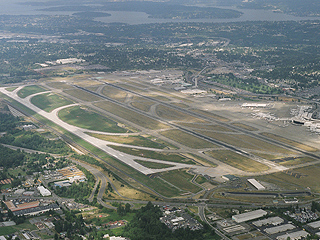Article Summary:
 |
November 20, 2008
Third runway an ‘environmental success story’
- Healthy streams, new wildlife habitat add a green dimension to infrastructure project
Seattle-Tacoma International Airport

Reis
|
From 10 miles aloft, an airport is a beacon to a pilot. But as the pilot gets closer, that simple-looking stretch of pavement gives way to the details of a highly complex transportation infrastructure.
Seattle-Tacoma International Airport’s third runway, opening today, is the Port of Seattle’s newest beacon. Already known as one of the region’s key transportation assets, what you see when you get closer is an environmental success story that’s good for business and good for our community.
Look closer and you’ll see spawning salmon within 200 yards of a major airport runway an 8,500-foot-long slab of concrete produced with greenhouse gas emissions in mind and crab shells that make water runoff cleaner than the creek it drains into.
One of the most challenging public works projects ever undertaken in the state of Washington, Sea-Tac’s third runway project required innovation and creativity to improve airlines’ on-time performance, reduce delay and improve customer service for passengers, and provide a greener, cleaner environment.
Fish-friendly waterway

Photo by Sky-Pix, courtesy of the Port of Seattle
Fly ash, a byproduct of burning coal, was substituted for nearly one-third of the cement in Sea-Tac’s new runway, shown on the left. Fly ash allows cement to be produced using less energy.
|
Those salmon are the latest examples of the project’s success. With the heavy rains of the past few weeks, we’ve been able to document Coho salmon in Miller Creek — west of the third runway project — in an area formerly littered with old tires, beer cans and creosote piers.
Over the past three years, our environmental project team created specific water conditions, installed native plants and woody debris along the creek for the perfect conditions for salmon, even creating quiet pools where fish can rest and beds of rocks for laying eggs.
The sight was almost magical, as not far away stood the reason why Miller Creek survived so close to the third runway: the largest retaining wall of its kind in the Western Hemisphere.
Standing about 130 feet tall and more than 1,400 feet long, the wall protects 113 acres of forested wetlands west of the third runway. This largest of three retaining walls within the project is less than 20 yards from the wetlands at its closest point.
In order to mitigate the impacts of filling about 20 mostly low-quality wetlands while building the new runway, the project transformed a 1,000-foot-long, ditch-like section of Miller Creek into a winding fish-friendly waterway, and installed more than 158,000 native plants in an area that previously was a pumpkin patch with a ditch.
By expanding, protecting and restoring critical areas at the airport, the port improved water quality and flood control for downstream and surrounding communities. At an average construction cost of $125,000 per acre, the port made an investment of more than $23 million in critical-area habitat and new floodplain.
What had been farm land sitting on former wetlands next to the airport now provides new floodplain storage for Miller Creek, helping reduce flooding, erosion and sedimentation downstream.
Similarly, the farms and homes surrounding an additional mitigation site on the Green River in Auburn flooded frequently. Now, flood water is stored in the port-built wetland complex and slowly released as the river recedes, reducing damage and preserving areas for residential development.
Bye bye birdies
The design and scale of the mitigation and the 15-year monitoring program is unprecedented, establishing a new benchmark in the state. This portion of the mitigation provides fish habitat in a highly urbanized area that also had to avoid attracting birds — a dangerous hazard next to an airport.
To balance this purpose, the additional 65 acres of open-water wetlands for waterfowl habitat was created on the Green River near Auburn. The waterfowl habitat that attracts birds was created away from the airport, since birds can be a hazard to aircraft.
More than 16 million cubic yards of dirt was used to raise the land up to the level of the current runways. If you lined up the number of dump trucks required to deliver the dirt, they would reach from here to Miami and back.
To manage as much as 8 million gallons of stormwater on the 350-acre project site, seven construction stormwater ponds were built with four treatment centers. The water was treated with chitosan, a recycled crab shell product that causes the soil particles to drop out of the water.
This water was then passed through sand filters before it was clean enough to release to area creeks. Over the course of the project we treated nearly 649 million gallons of stormwater.
Turning to the runway itself, fly ash, a byproduct of burning coal, was substituted for nearly one third of the cement. Fly ash content allows cement to be produced using less energy.
This reduced the amount of greenhouse gas emissions associated with construction. Overall, the 8,500-foot-long, 150-foot-wide runway is 17 inches thick.
The third runway is expected to save another 50,000 tons of greenhouse gases from aircraft emissions and over 5 million gallons of fuel per year. In its first full year of operation, travel delays will be cut in half, saving airlines and travelers tens of millions of dollars.
More than infrastructure
Five years ago, Sea-Tac Airport’s economic impact to our region was estimated at $9.7 billion dollars, including more than 190,000 jobs. The third runway project and the lessons learned from it will make that benefit even greater as our region and the demand for efficient air travel continues to grow.
From a distance Sea-Tac’s new runway looks simply like a flat piece of pavement. But as you can see, the details are much more compelling.
The new runway is more than critical infrastructure that will serve our airline customers, the flying public and our regional economy. It is also demonstrates that we can promote economic prosperity while protecting and enhancing the environment.
Mark Reis is managing director of Seattle-Tacoma International Airport, a division of the Port of Seattle.